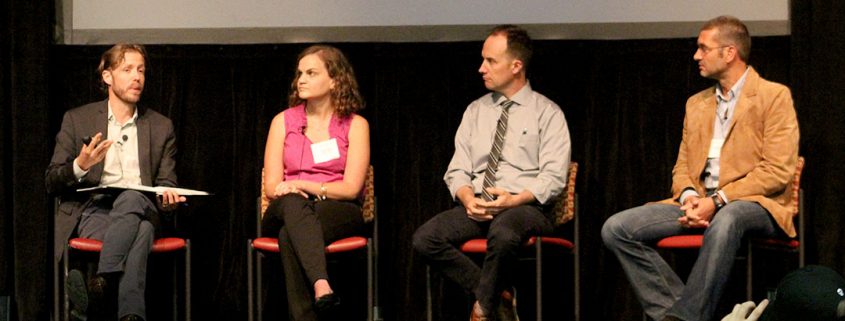Summit tackles issue of plastics in ocean
A crowd of students watched as Cassandra Davis, a representative of the Aquarium of the Pacific in Long Beach, held up two identical jars, one with several moon jellyfish and the other with a plastic bag. Davis said that though humans could tell the two jars apart, on the open ocean it might not be so easy for the sea turtles that may confuse the plastic with their prey.
“They’re going to be drifting along, often in the same currents,” Davis said. “When they are out in the ocean current, they look and act like jellies. It’s easy to see the confusion when you hold them side by side.”
The demonstration took place at the Plastic Bag Ban Summit, hosted in the Trojan Ballroom on Wednesday afternoon by the Benioff Ocean Initiative at UC Santa Barbara in conjunction with the Monterey Bay Aquarium. The summit included a panel discussion on the ways plastic waste manifests in the ocean ecosystem and its impact on humans, as well as what actions need to be taken to address the pollution.
The Aquarium of the Pacific is hoping to raise awareness by using the jars to demonstrate just how easy it is for marine life to become confused and ingest plastic. Davis said that even if the sea turtles do not directly eat the plastic, the jellies on which they feed may. The plastic, and the chemicals from it, stay in the system of the jellyfish, then travel up the food chain until they reach the animals at the top.
This makes humans vulnerable as well, Davis said. Most plastic remains in the stomach of fish, posing a threat to people who consume this part of the fish. Furthermore, schooling fish, like sardines, are caught and ground into feed for domesticated animals, making it possible for the plastic contaminants to enter the human body through chicken.
Jennifer Brandon, a Ph.D. candidate who is researching microplastics through the SCRIPPS Institute of Oceanography, said that one of the biggest misconceptions about plastic waste pollution in the ocean is that it takes the form of a large island of trash in the middle of the ocean. The reality is that garbage patches, which tend to occur at convergence points of major currents, only consist of a few large pieces of plastic waste. The rest is what has been called “microplastic.”
“Most of the plastic in the ocean is very small,” Brandon said. “Ninety percent are smaller than a quarter of an inch, but we started to realize that these pieces are even more dangerous. They are much harder to clean up and much easier to eat.”
Brandon said that an increasing number of bottom-feeders have been found with plastic in their stomachs, which can impact predators at the top of the food chain. Studies conducted by the SCRIPPS Ocean Institute have found that about 34 percent of gooseneck barnacles examined had plastic in their guts. In South America, these organisms are considered a delicacy, creating a direct path for plastic to be ingested by humans.
Other studies have been conducted on copepods, one of the most abundant organisms in the world. In an experimental setting, they have been proven to eat plastic, and Brandon said that because they are one of the key building blocks for the entire oceanic food chain, the implications could be devastating.
According to Brandon, plastic smaller than one-third of a millimeter across escapes most nets, making it difficult to measure how much of it is actually in the ocean. Because of the tendency for plastic to break down into infinitely smaller pieces, it is possible that this form of plastic, called “nanoplastic,” is the most prevalent.
Roland Geyer, an associate professor at UC Santa Barbara’s Bren School of Environmental Science and Management, said that there are also studies being conducted to determine which countries contribute most to the plastic problem.
“Out of the top 20 countries, 18 are South Asian,” Geyer said. “This is because they have high a population density along with recent economic development, so they use a lot more plastic, especially in packaging. They also don’t have the infrastructure to deal with plastic waste. It’s the perfect storm.”
The United States also appears in the top 20, due to its large population and coastal areas. Panelists agreed that California has pioneered the way for increased environmental regulation, inspiring the laws of other states as well as across the globe, but said that issues in combatting plastic pollution still remain.
For example, plastics are currently manufactured to withstand whatever they are being used for, making it very difficult to dispose of them properly. To address this problem, panelists emphasized that the solution may need to come from the industries that manufacture plastics, rather than relying on the government.


Interesting. But what does ‘summit’ mean? Who was there, and what are they at the top of (except the food chain)?